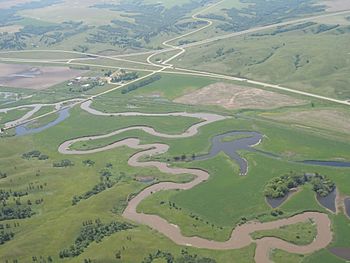Des Lacs River facts for kids
The Des Lacs River is a cool river in central North America. It flows through Saskatchewan in Canada and North Dakota in the United States. The river starts in southeastern Saskatchewan and flows into the Souris River in Burlington, North Dakota. It's the main river that feeds into the Souris River. Its name comes from French, meaning "River of the Lakes," given by early fur trappers.
Quick facts for kids Des Lacs River |
|
|---|---|

The Des Lacs River in North Dakota.
|
|
| Country | United States, Canada |
| Region | Saskatchewan, North Dakota |
| Cities | Burlington, North Dakota, Kenmare, North Dakota |
| Physical characteristics | |
| Main source | Southeastern Saskatchewan, Canada 48°35′25″N 101°59′49″W / 48.5902778°N 101.9969444°W |
| River mouth | Souris River North Dakota, United States 1,558 ft (475 m) 48°16′47″N 101°25′08″W / 48.2797222°N 101.4188889°W |
| Basin features | |
| River system | Souris River basin |
How the River Was Formed
About 10,000 years ago, the Des Lacs River was formed. It happened when huge amounts of water burst from two giant glacial lakes. This was like a massive flood from melting ice.
The Des Lacs River flows all year round. You can see many old oxbow lakes along its path. These are U-shaped lakes formed when a river bend gets cut off. Before people settled here, the river's floods helped create many wetlands, ponds, and marshes.
Over time, people changed the river a lot. They dug ditches to drain water and straightened parts of the river. They also built many small dams along it. Because of these changes, not many natural wetlands are left today.
History of the Des Lacs River Valley
Long ago, several Native American groups used the Des Lacs River valley. These included the Assiniboine, Sioux, Mandan, Hidatsa, Plains Ojibwe, and Atsina peoples. They used the area for hunting animals or as a path for trading. The Assiniboine tribes were the last native people to live in the valley before European settlers arrived.
Early settlers came to the region in the early 1880s. They were mostly ranchers who claimed land for their cattle. By 1880, a Lignite coal mine was already set up near where the river joins the Souris.
Getting to the area became easier when the Great Northern Railway arrived in 1886. Then the Soo Line came in 1893. After 1896, more people started settling in the valley, and towns were built. For a short time, the Des Lacs River was even used to transport grain by boat to Kenmare, North Dakota. From there, the grain was loaded onto trains.

